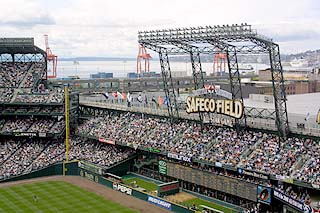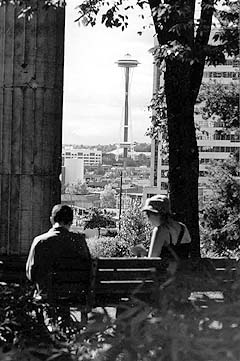
DJC.COM
August 9, 2001
Protecting views makes sense from every angle
Special to the Journal

Photo courtesy of the Seattle Mariners The Seattle City Council is deciding if Martin Smith Inc. can build out the Wosca site above the current limit of 65 feet. Views from Safeco Field would be obstructed by a taller building. |
When asked for his opinion about protecting views, Mayor Paul Schell points out “we can’t save yesterday’s sunset.” That may be true but it’s tomorrow’s sunset we’re worried about.
In the last three years, there has been much public concern about the loss of views both downtown, where new towers reach skyward, and throughout the city where the effects of urban infill and site/height-maximized projects are felt in the neighborhoods.
The pressure has been enough for the City Council to put view protection on its policy docket, the place where difficult issues suffer in the purgatory of legislative analysis until they are rescued by an ordinance or resolution.
In Orwellian fashion, the current ordinance under consideration seeks to solve the vexing legal problem of the Space Needle view by determining that the way to protect public views of the landmark under Seattle’s SEPA (State Environmental Policy Act) rules is to eliminate that protection from all but a handful of locations.
One place the protection is eliminated is Four Columns Park. Perched above Interstate 5 at Boren and Pike, the quirky, unique park with its postcard view of the Space Needle framed between the columns, is in the crosshairs of the Denny Triangle Density Militia, who, armed with their declaration of rights from transfer of development credits (TDC) and new height bonuses, vigorously resist the desire of their uphill neighbors in Pike-Pine to protect the little view park, lest any percentage of development capacity be lost to that view.
The battle of Four Columns Park showcases the issues and perhaps the answers to the public view protection conundrum.
Why are public views important?
Views are civic soul food, providing cultural identity, orientation and sense of belonging in a place. Everyone who travels from Sea-Tac Airport via the Alaskan Way Viaduct experiences the feeling of homecoming as the downtown skyline and Elliott Bay waterfront come into view.
You won’t get that rush in a tunnel, no matter how efficient it might be. Similarly “greenstreets” — the urban amenity du jour — will not alone compensate for the claustrophobic effects of a phalanx of skyscrapers eclipsing views across the Denny Triangle and South Lake Union from Capitol Hill and I-5, recognized in SEPA as a scenic corridor in this vicinity.
View corridors are open space — visual oxygen in the dense downtown neighborhoods and should be treated with at least as much respect as curb bulbs and bike racks.
What is a view worth?
Was the future of Seattle depicted on the cover of the New Yorker magazine’s June 11th issue? “Spctclr riv vue” the cartoon illustration of two real estate shoppers’ longing gaze at a “peekaboo” view of the East River from the umpteenth floor must have set off some alarms in Belltown! Private views east of Alaskan Way are on the way to becoming “yesterday’s sunset.”
That makes protecting public views all the more necessary to prevent the excess privatization of Seattle’s defining vistas. A few months ago, the Seattle Parks Department rushed in with $3 million to save the view of the future Sculpture Garden from a private development at Broad Street but is foot dragging over a less expensive property acquisition — one approach to the Four Columns Park problem, by replacing the park and view in another location.
Both parks have “full views” of the Space Needle by the city’s own definition in its report entitled Seattle View Protection Policies Vol. 2: Space Needle View Inventory and Assessment, yet Four Columns Park is dismissed by some council members as being too noisy and gritty to bother with.
If noise and grit are the criteria, what about the inconvenient fact that a major truck route (Elliott Avenue) and the mainline of the BNSF railroad run through the middle of the Sculpture Garden?
The real issue is the city’s reluctance to place a value on public views so they can compete in the marketplace with private views.
The view from Four Columns Park is a public asset; allowing a private development to appropriate it should be mitigated, compensated or disallowed. After all, the future beneficiaries of that view in offices and private residences will pay handsomely for it. This is no different from the requirements for compensating the public for street vacations. Yet there are some public views so essential they cannot be traded or replaced.
What is an essential public view?
The overwhelming sympathy for protecting the view from Victor Steinbrueck Park in the dispute over the design of the Marriott Hotel on Alaskan Way will be tested again soon as the Pike Place Market PDA reveals its plans for developing the site immediately south of Steinbrueck Park.

Photo by Jill Janow Protecting the Space Needle view from Four Columns Park is a hot topic in Seattle.
|
Called PC-1 North, the site is currently a nearly invisible sunken surface parking lot. But given the zoning and Pike Place Market’s need for revenue and expansion space, the open view now provided across the site from the Desimone Bridge, the Market North Arcade windows, the craft tables extending along Pike Place, and from Steinbrueck Park itself, is at risk.
Earlier plans suggested extending V.S. Park on top of any structure on the site. To do that, and terrace down following the steep slope, will reduce development capacity. But what is more valuable to area residents and a zillion visitors than Pike Place Market with a view of the waterfront?
The $372 million public view — Safeco Field
From Lookout Landing and many seat sections, Safeco Field offers spectacular elevated views of Puget Sound, the Olympic Mountains, waterfront activities and the city skyline. This is the hometown view writ large and punctuated by the guardian Space Needle.
The City Council will decide the fate of this view when they vote on a contract rezone proposed for the Wosca site immediately west and north of the stadium. Currently zoned at 65 feet, Martin Smith Inc. wants to build to 125 feet. To do so would take the public view and convert it to a private view.
Some City Council members want to deny that the view is public because people generally buy a ticket to the game. Ignoring the fact that millions in tax revenues built the stadium, if charging admission makes it private, does that mean the aquarium, zoo and all public pools, golf courses and picnic shelters are really private because fees and admissions are also charged to use them?
When circumstances like the construction of Safeco Field provide the public with the lemonade of wonderful views, the city should not make a lemon out of it.
Rezone? Just say ‘No.’
Is view protection really about stopping growth?
Critics of enforcing regulations to protect public views argue that we won’t meet our GMA mandated growth targets if we insist on view preservation, especially downtown. The question is which targets — job growth or housing growth? The real shortage is in housing, but the types of projects likely to block the view from Four Columns Park will only perpetuate the jobs/housing imbalance.
According to the city’s analysis, the 30 parcels in the view corridor have a capacity of “2.5 million square feet of commercial space (10,000 jobs) and 725 residential units.” But even this prediction fails to account for the fact that protecting a view corridor from Four Columns Park can be achieved with creative siting and building design. In fact, the preferred alternative for the county’s transit oriented development at Convention Place is the one which maintains the view from Four Columns.
Even with decades of effort, we have failed to plan for view corridors in conjunction with greenstreets, jobs and housing — despite the fact that since the initial SEPA ordinance in the 1970s, protection of certain views was (and remains) official land use policy. Yes, it requires some balancing of interest to have views and new buildings, but until recently the scales have been weighted toward ease of development and against mitigation for view protection.
The case of the Marriott Hotel on the waterfront points out how that balance can be achieved by design changes. A lowered and sculptured hotel will open water and mountain views over the roof. In addition, roof itself will be worth a second glance. The developers have agreed to treat the roof as a canvas for artwork in recycled glass, thus adding an interesting element to the public view. Since rooftops are a common element in city views, a higher standard of design for the fifth façade is in order.
Views to the future
At a public hearing a few months ago, two transplants from Manhattan now living on Capitol Hill were incredulous that Seattle’s land use regulators would trade something as unique as the view from Four Columns Park for something — in their words — “as common as another tall building.”
Seattle’s scenic pleasures are the seed corn of our quality of life. To gobble up our seed corn now in a rush to exploit current economic trends and philosophies about land use is short sighted at best.
The responsibility for protecting our scenic resources falls largely to DCLU, but does not stop there. Property owners and developers also bear some social responsibility not to hog the view. The City Council should not cripple view protection policies as they recently did in allowing a 25-foot height increase on property immediately adjacent to the South Lake Union shoreline. This expedient bargain put a few extra dollars into the city’s coffers when selling surplus property to investors, but it will be regretted soon enough.
As we approach the city’s sesquicentennial celebration, we should recall the efforts of Victor Steinbrueck, architect, author, activist, and view preservationist. In 1965 he wrote: “If Seattle were the most beautiful, most cultured, most liveable city in America, its future would be insured in every way! The unique and marvelous natural setting hold the potential for this possibility. The will of the citizenry and the strength of the decision making leaders in public and private positions are the missing ingredients presently.”
The citizens are willing, now the leaders should step up to the challenge — 36 years is long enough to wait.
Irene Wall is an assistant business development manager for HDR Engineering, and president of the Phinney Ridge Community Council. She established a public interest group SAVE (Save A View for Everyone!) in 1999 related to filing an appeal of the permit for the waterfront Marriott Hotel to preserve the view from Victor Steinbrueck Park.
Other Stories:
- The future is looking UP
- Urban form gets its roots from nature
- Downtown becomes a shopping mecca
- Earth-shaking discoveries impact design
- The scoop on infill development
- Infill problems? Get creative
- Rubbernecking leads urban retail revival
- Rx for Seattle’s growing pains: Collaboration
- DSA puts a downtown neighborhood on the ‘Edge’
- Public places — look between the buildings
- A blast from the past — modernism is back
- Getting the ball rolling with affordable housing
- Energizing Everett
- Urban development versus the public process
- Urban development picture includes artists
- Pricing gridlock out of the market
- Retail? Start with the first floor
Copyright ©2009 Seattle Daily Journal and DJC.COM.
Comments? Questions? Contact us.